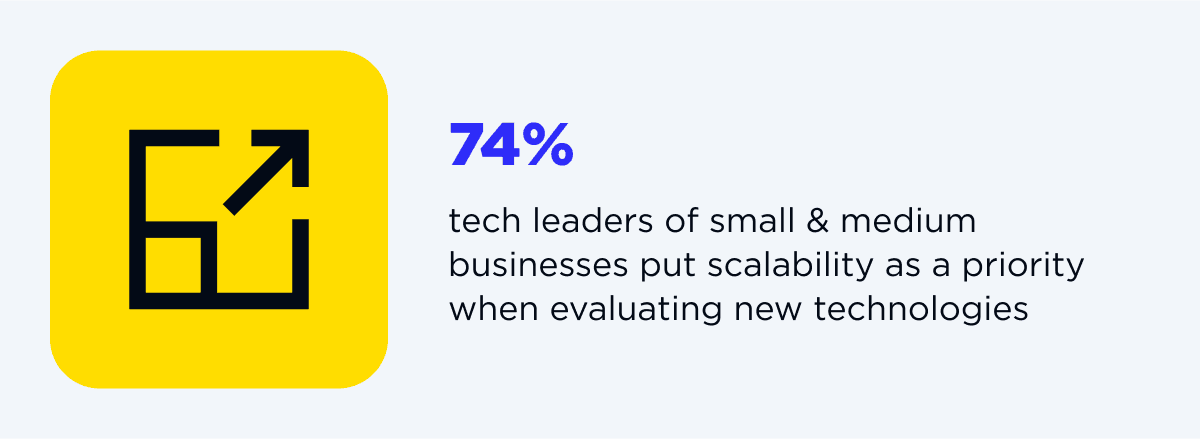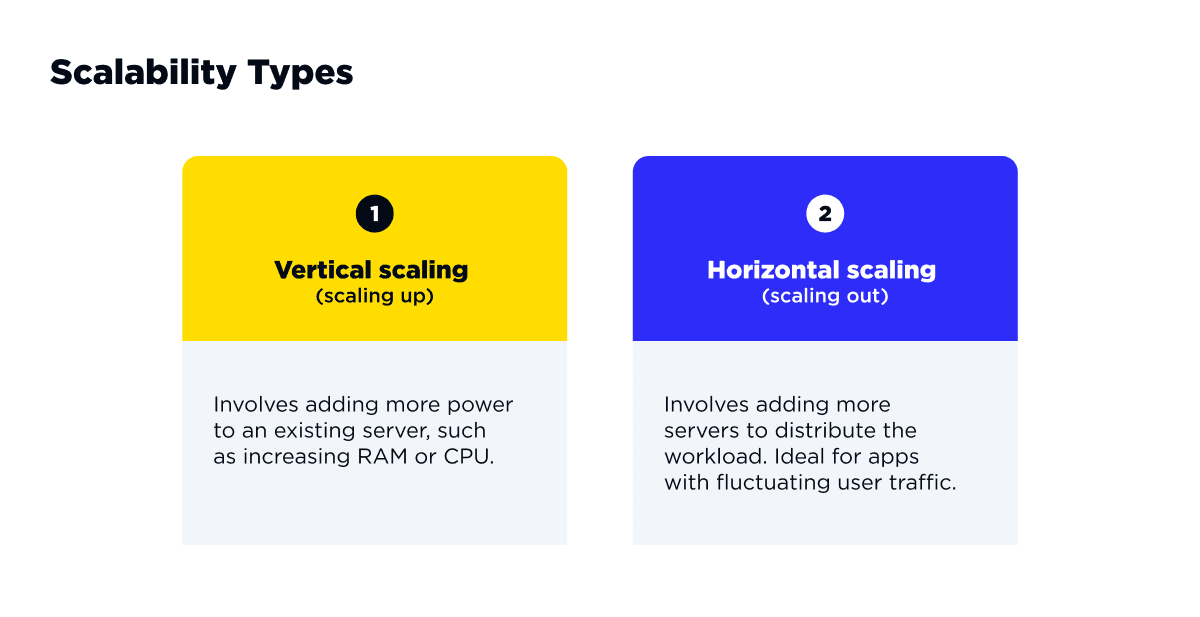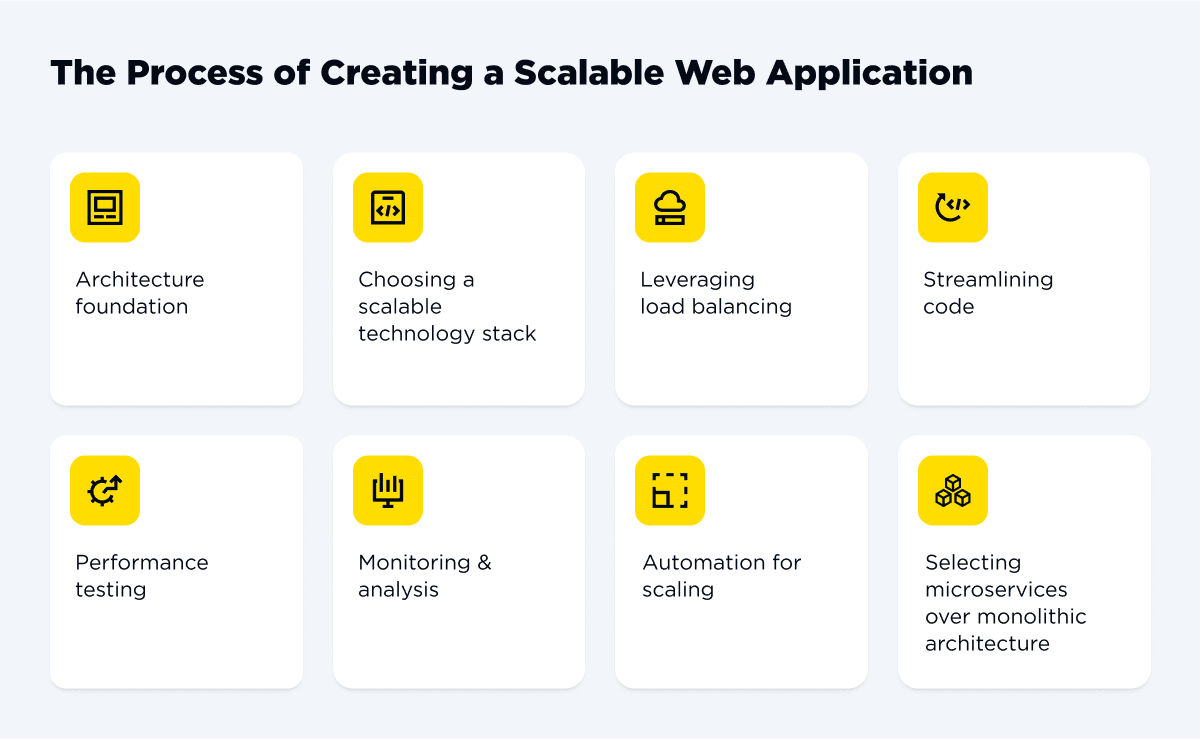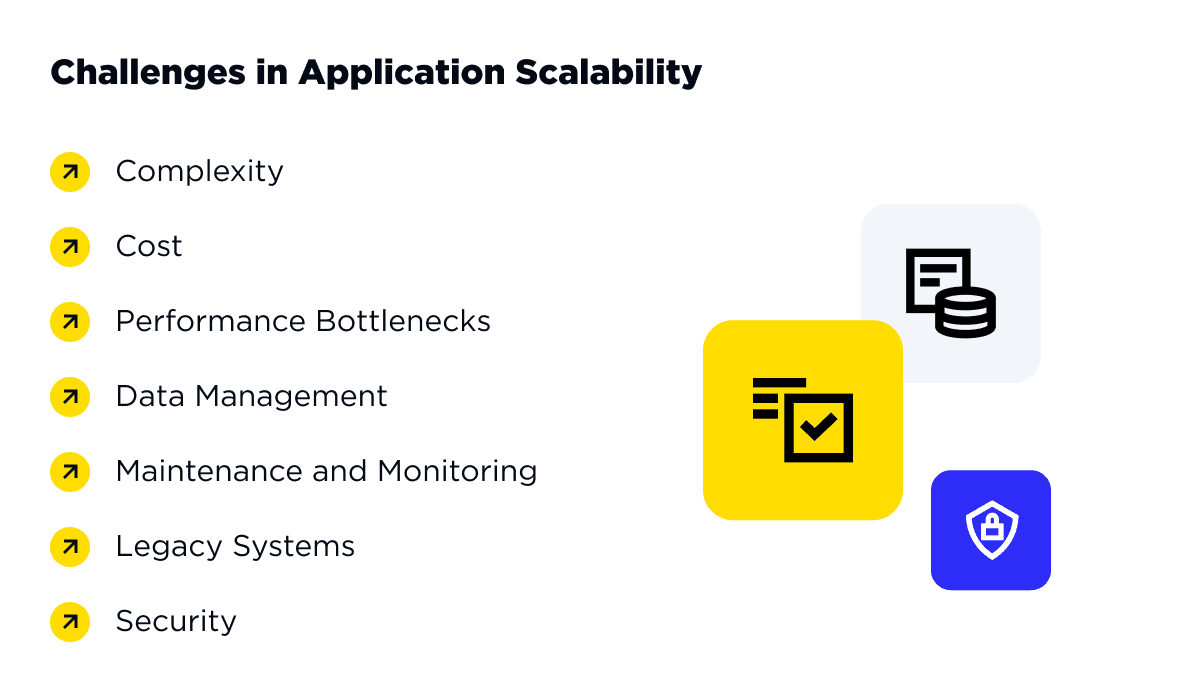The times when owning your brand’s app was the main competitive advantage are a long way in the past. Just a powerful app is not enough anymore. We’ve already entered the era of scalable applications. Moreover, according to a Salesforce report, about 74% of SMB tech leaders put scalability as a priority when evaluating new technologies.

Picture this: your app is blowing up. Downloads are skyrocketing, users are flocking in, and it feels like you’re on top of the world. But then, suddenly, the app crashes, or it starts slowing down because it can’t handle the load rates. What may happen to all thrilled users? How do you restore your reputation? This is where scalability comes into play! it doesn’t really matter whether you’re running a startup or managing a global brand, it is essential to make sure your app can handle growth and any loads. It can help you keep users happy and ensure your business succeeds. Scalability is like a secret tool behind every high-performing app. The best examples of such are loved-by-everyone apps like Spotify, TikTok, and Amazon.
So, what does it take to build an app that can grow with you and handle whatever comes? Get ready, as we’re taking you on a journey of application scalability. By the end of this article, you’ll know why it matters, how to master it properly, and how to avoid common pitfalls. Let’s go!
How Do You Define Scalability In App Development?
First things first, let’s find out what scalability in app development refers to. In simple terms, it is an application’s ability to handle the increased workload, user demand, or data growth without compromising its performance or functionality. As a result of efficient application scalability, your team can ensure that as your app grows, whether in terms of users, features, or operations, it can continue to deliver the same or even better level of reliable experience.
If to speak metaphorically, you can think of scalability as building a house with the potential for future extensions. Imagine that at first, you need just two rooms, but you plan for the possibility of adding more floors or rooms later. The same rule applies when developing an application. We would like to give you probably the best and most successful examples of such apps as Netflix and Uber. Initially, they began their launch with limited features but were built with scalability in mind. At the end of the day, they have expanded globally and are able to support millions of users worldwide daily.

Would you like to build a reliable ground for your application?
Contact usWhat Makes Scalability So Important?
Scalability is the milestone of any successful app, especially as it grows. In fact, your app might work fine without it, but when you're just starting out. However, when traffic plummets, performance can tank, leading to frustrated users and lost opportunities. That is why a scalable app ensures it can handle increased demand without skipping a beat. It keeps users happy, your business running smoothly, and costs in check. Simply put, scalability is what lets your app evolve without breaking down along the way. Let’s discover what other reasons make application scalability so crucial.
Better retention and user satisfaction
Imagine trying to order food on a Friday night through an app, but it crashes due to high demand. Frustrated, you switch to a competitor or just start cooking yourself. This scenario highlights how scalability impacts user satisfaction. Scalable apps ensure consistent performance during peak usage, keeping users happy.
Example: Take Spotify. With millions of users streaming simultaneously, its scalable application architecture ensures smooth playback without interruptions, even when new users join. Have you ever noticed any crashes? Exactly!
Higher revenues and boosted business growth
Scalability is essential for businesses that aim to grow. An app that handles increasing users and transactions smoothly can unlock new markets and revenue streams. When you successfully manage to scale your app, you can avoid any losses of revenue and opportunities.
Example: Amazon’s app scales effortlessly during events like Prime Day. It can easily process millions of orders while maintaining proper performance.
Applications with cost optimization in mind
Some people consider application scalability like an upfront investment. Actually, it is quite the opposite. It often reduces costs in the long run. Scalable systems allocate resources efficiently, ensuring you only pay for what you really use. Cost efficiency in action!
Example: Cloud services like AWS and Azure offer elastic scaling. It allows businesses to adapt their infrastructure to changing demands without spending too much on that.
Enhanced app resilience and reliability
Reliability and the app’s resilience are crucial because you can sometimes underestimate your users. In other words, you can not always predict when you may have high loads. However, when you own a scalable app, you can have peace of mind that your app is more resilient to unexpected spikes in traffic or failures.
Example: During major events like Black Friday, Shopify’s scalable infrastructure ensures e-commerce websites remain operational. Even when they face a sudden influx of shoppers, they can keep providing top-notch customer service.
Adaptability to any change or demand
The world of technology is fast-paced, competitive, and unstable. That is why it is crucial for your application to have proper adaptability features. As a result, a scalable app allows you to integrate new features or adjust your business model quickly and efficiently.
Example: TikTok’s ability to scale and innovate rapidly has played a significant role in gaining traction.
What Types of Scalability Can You Consider?
When it comes to scaling your app, it’s not a one-size-fits-all approach. There are different ways to scale depending on your needs and business growth trajectory. Whether you’re adding more power to a single server or expanding across multiple machines, understanding the types of scalability can help you make smarter decisions and ensure your app stays flexible, efficient, and ready for anything. Let’s discover the key options you can consider.

Vertical scaling (scaling up)
Vertical scaling involves adding more power to an existing server, such as increasing RAM or CPU capacity. The vertical scalability approach is straightforward and effective for mobile applications that don’t require distributed systems.
For example, Instagram initially scaled vertically to manage its growing user base before moving to horizontal scaling.
Horizontal scaling (scaling out)
Horizontal scaling involves adding more servers to distribute the workload. This is ideal for apps with unpredictable user traffic spikes.
For example, Airbnb uses horizontal scalability to handle increased demand during holiday seasons when millions of users book accommodations simultaneously.
What Is The Process Of Creating a Scalable Web Application?
Building a high-performance application isn’t just about adding more servers or increasing bandwidth. It’s a thoughtful process that involves planning for growth from the start. Whether you're launching a new app or scaling an existing one, every decision affects how well your app can handle future demands and response times. Let’s explore the key steps in the app development process.

Opting for the right architecture
The foundation of a scalable app is its architecture. We do recommend opting for cloud-based solutions and distributed systems that can grow along with your needs. Companies like Slack have successfully implemented scalable architectures to support their ever-growing user base.
Choosing scalable technology stack
Choose frameworks, programming languages, and databases that can handle future growth. Database scalability is crucial for smooth app performance. First of all, make sure to choose between relational (e.g., PostgreSQL) and non-relational (e.g., MongoDB) databases based on your scalability needs, consider sharding, database replication, or using caching. For instance, Node.js and React are popular choices for scalable web apps, while databases like MongoDB and PostgreSQL are known for their flexibility and optimal performance. Facebook, for example, combines database scalability and caching for being able to handle billions of users.
Leveraging load balancing
Load balancing ensures that traffic is distributed evenly across servers, preventing any single server from being overwhelmed. What is more, you may want to consider implementing a content delivery network (CDN) alongside load balancers. It also adds up to further improvement of performance by distributing content closer to users. As a result, it reduces latency and enhances the overall user experience. Google Cloud’s load balancers are a great example of how this technology keeps apps like YouTube running smoothly, even with billions of users.
Streamlining code
Efficient code is critical for scalability. During this stage, your dedicated team of developers you’ve partnered up with reduce unnecessary computations and optimize database queries to improve performance. For example, Facebook regularly refactors its codebase to handle increasing user demand. No wonder Meta Corporation is so successful. Have you noticed how many times we’ve mentioned it as an example?
Performance testing
Performance testing is another vital step in ensuring your application can handle all the scaling demands. This testing includes simulating user load testing, stress-testing the infrastructure, and pinpointing inefficiencies in your app’s design. You can always involve third-party services like Apache JMeter, Gatling, and LoadRunner to assess how your application behaves under peak loads and identify room for improvement.
Monitoring and conducting analysis
Regular monitoring helps identify potential bottlenecks before they become critical. Third-party services like Datadog or New Relic provide insights into application performance, allowing companies to scale proactively. It is essential to monitor resource usage as well to make sure your app doesn’t overuse or underutilize infrastructure. You can get real-time insights and reduce unneeded operational costs. The main scalability metrics to consider include CPU usage, memory usage, disk I/O, and network bandwidth.
Setting up automation tools for scaling
Automation is crucial nowadays and scaling your app is not an exception. Automation tools like Kubernetes allow apps to scale automatically based on demand. For instance, Zoom relies on automated scaling to handle sudden surges in users during large online events. Well, there are some advantages of the pandemic, as it really boosted Zoom to scale.
Selecting microservices over monolithic architecture
Some may say it’s a minor step. Yet, it is super vital. Breaking down an application into smaller, independent services rather than applying monolithic architecture makes scaling easier. Netflix famously transitioned to a microservices architecture, enabling it to scale each service individually and improve resilience.
What Challenges Can You Stumble Upon in Application Scalability?
Scaling an app sounds great in theory, but in reality, it comes with its own set of challenges. Even though monolithic applications come with their own complications, scalable ones can also create some burdens.
From managing complex systems to dealing with unexpected performance issues, app scalability isn't always smooth sailing. As your app grows, you might face issues that could slow down progress or even cause setbacks. It is only fair to explore the common scalability issues you might encounter and how to overcome them.

Complexity
Building a scalable app involves complex planning and design. Managing distributed systems and ensuring data consistency across multiple servers can be daunting.
Use case: Netflix has successfully managed the complexity of distributed systems. They build Chaos Monkey, which is a tool that tests system resilience and ensures consistency across all servers.
Cost
While application scalability optimizes costs long-term, the initial investment can be significant. Other additions to the expenses include cloud infrastructure, skilled developers, and monitoring tools.
Use case: Airbnb coped with high initial costs by leveraging Amazon Web Services (AWS) to scale its infrastructure.
Performance bottlenecks
As an app scales, performance bottlenecks like code issues, database queries, or server configurations can limit performance. Identifying and addressing these potential problems is crucial.
Use case: For example, LinkedIn improved app performance by optimizing database queries and introducing Apache Kafka (it handles real-time data processing).
Data management
Handling large volumes of data efficiently requires robust databases and storage solutions. Involving an experienced team like OTAKOYI can be a lifesaver.
Use case: For example, Uber processes terabytes of data daily, relying on advanced data management systems to maintain scalability.
Maintenance and monitoring
Scaling an app is an ongoing process. Continuous monitoring and updates are necessary to ensure the app adapts to all changing demands.
Use case: Spotify has found a solution and ensures seamless scalability through continuous monitoring with tools like Prometheus and Grafana.
Legacy systems
Integrating new scalable systems with existing legacy infrastructure can be challenging. Many enterprises, like banks, face hurdles in modernizing their outdated technology stack for app scalability.
Use case: Adopting microservices architecture helped JPMorgan Chase to modernize its legacy systems.
Security
As apps scale, so do potential vulnerabilities. Implementing robust security measures is essential to protect user data and maintain trust.
Use case: As mentioned earlier, Zoom streamlined its scalability and security by implementing end-to-end encryption and robust authentication methods.

Learn how we can scale your application to new heights.
Contact usWrapping Up: Why Application Scalability Matters?
As you may have already understood, scalability is more than just a technical buzzword. Nowadays, it’s a critical aspect of app development that ensures long-term success for your business. We urge you to prioritize scalability so that your business can improve user satisfaction, support growth, optimize costs, and stay resilient in this highly competitive digital world.
OTAKOYI: Your Partner In Seamless Application Scaling
Our OTAKOYI team specializes in creating scalable, future-proof applications tailored to your business needs. When working with us, you get:
#1 Tailored scalability strategy
A custom scalability plan for your business needs, growing without hiccups.
#2 Expert guidance
Profound experience across industries like retail, healthcare, and finance, deep insights on the best technologies and architecture.
#3 End-to-end support
Full-cycle support and continuous scalability as your app evolves.
#4 Future-proof solutions
Scalable applications to stay ahead of the competition and be adaptable to future technology trends and user demands.
#5 Seamless performance monitoring
Advanced performance monitoring tools to catch potential issues before they impact users.
#6 Cost-effective scaling
Optimize resource utilization and cost savings by focusing on the most efficient scalability strategies.
#7 Reduced time to market
Development teams of dedicated professionals who get your app to market faster while ensuring it’s built for long-term growth.
#8 Ongoing innovation
Our commitment to innovation equals your app is never static and your business develops alongside the latest tech advancements.
Partner up with OTAKOYI to let us help you turn app scalability from a challenge into an advantage!




